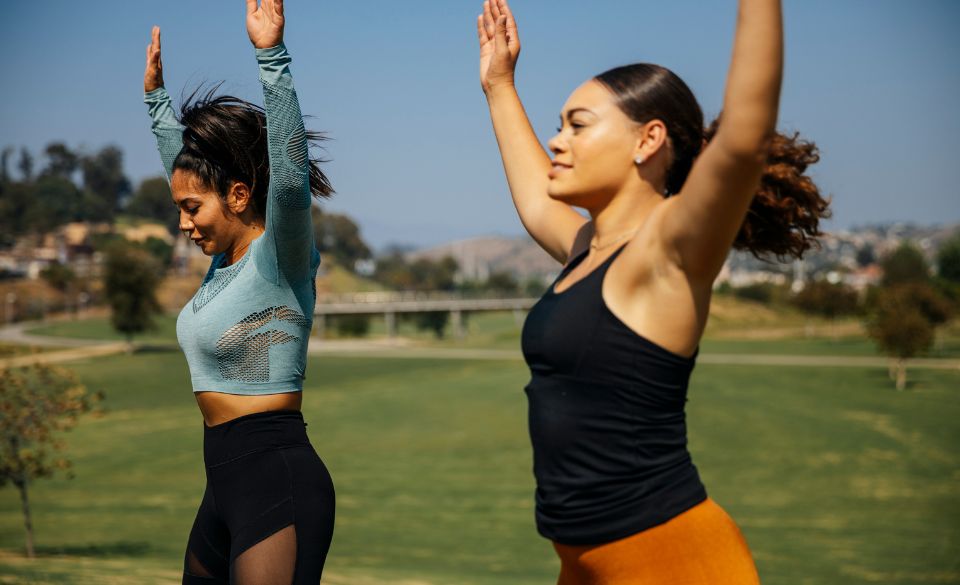
6 Exercises and Tips to Help You Jump Higher
Page Contents
Mastering the skill of jumping higher not only enhances your performance in sports like basketball, volleyball, and track and field but also cultivates power, balance, and agility—attributes that transcend both functional and athletic movements. Explore the exercises and tips below to propel yourself to new heights, fostering a more dynamic and resilient physique.
Exercises to Boost Your Vertical Jump
Achieving an impressive vertical jump is a goal shared by athletes across various sports, from basketball to track and field. A higher vertical jump not only enhances athletic performance but also signifies improved strength, power, and agility. In this section, we’ll explore a set of targeted exercises designed to elevate your vertical jump, focusing on key muscle groups and fundamental techniques. Whether you’re a seasoned athlete looking to enhance your jumping ability or a beginner eager to take your first leap, these exercises offer a comprehensive approach to boost your vertical jump and overall athletic prowess. Let’s dive into the world of vertical jump training and unleash your full jumping potential.
1. Jumping Jacks
How to do it:
– Stand with feet hip-width apart, arms alongside your body.
– Jump up, spreading your feet apart, and raise your arms overhead.
– Return to the starting position.
– Sets and reps: 2–5 sets of 10–20 reps.
2. Single-Leg Deadlifts with Jump
How to do it:
– Extend your right foot behind, leaning forward, aligning your torso parallel to the floor.
– Jump up, lifting your left foot and raising your right knee.
– Return to the starting position.
– Sets and reps: 2–4 sets of 3–10 reps on each side.
3. Burpees
How to do it:
– Drop into a squat position, then jump back into a high plank.
– Perform a pushup, return to squat, and explosively jump up.
– Sets and reps: 1–2 sets of 10–16 reps.
4. Forward Linear Jumps
How to do it:
– Stand with feet under hips, drop into a squat, and jump forward.
– Extend arms behind and land, pulling legs forward.
– Return to the starting position.
– Sets and reps: As many reps as possible with proper form.
5. Squat Jumps
How to do it:
– Lower into a squat position, then explosively jump up.
– Draw knees toward torso while in the air.
– Land gently and return to the starting position.
– Sets and reps: 2–4 sets of 6–12 reps.
6. Rebounding (Mini-Trampoline)
– Try exercises like jogging and intervals for an immersive jumping experience with less joint stress.
Tips for Maximizing Vertical Jumps
Warm-Up:
– Always warm up before jumping exercises to prepare your body.
Form is Key:
– Perfect the form of each exercise before aiming for higher jumps.
Maintain Knee Bend:
– Keep a slight bend in your knees to absorb impact effectively.
Land Softly:
– To reduce impact stress, land softly, and consider using foam tiles or cushions.
Utilize Arm Momentum:
– Swing your arms to harness momentum for higher jumps.
Level Landing:
– Ensure your feet land at the same level when jumping and landing.
Diversify Your Fitness Routine Cardiovascular Training:
– Boost overall health, reduce stress, and enhance mental function.
Strength Training:
– Develop muscular strength for powerful, efficient movements.
Joint Mobility Exercises:
– Improve flexibility and range of motion, contributing to better jump performance.
Consult a Professional
If you’re new to exercise or have health concerns, seek guidance from a fitness professional. A personal trainer can tailor exercises to your fitness level, address concerns, and ensure correct form, crucial for high-impact exercises.
Conclusion: Elevate Your Fitness Journey
Incorporate these exercises and tips into your routine for a well-rounded approach to jumping higher. Track your progress, prioritize recovery, and modify your program as needed. By combining jump training with cardio and strength sessions, you’ll not only boost your vertical jump but also foster a holistic fitness regimen, promoting overall well-being and athletic prowess.
Frequently Asked Questions (FAQ)
What exercises make you jump higher?
Several exercises are effective in enhancing vertical jump performance. Here are some key exercises that target the muscles involved in jumping:
Squat Jumps: Combining a squat with an explosive jump engages the lower body muscles, including quadriceps, hamstrings, and glutes.
Box Jumps: Jumping onto a box or platform focuses on explosive leg power and landing mechanics, crucial for improving overall jump height.
Lunges: Both forward and reverse lunges help strengthen the muscles in your legs, promoting stability and power.
Calf Raises: Strengthening the calf muscles contributes to the push-off phase during a jump.
Jumping Jacks: This plyometric exercise improves cardiovascular fitness and lower body strength, essential for an effective vertical jump.
Single-Leg Exercises: Incorporating exercises like single-leg squats or single-leg deadlifts enhances balance and targets individual leg strength.
Depth Jumps: Involving stepping off a box and immediately jumping upon landing, this exercise improves reactive strength and the stretch-shortening cycle.
Bulgarian Split Squats: This variation of the squat isolates each leg, focusing on strength and stability.
Power Cleans: A weightlifting exercise that enhances explosive power in the hips, thighs, and calves.
Plyometric Push-Ups: This exercise engages upper body muscles and promotes explosive arm strength, which can contribute to overall jumping power.
How do I get my jumps higher?
Improving your vertical jump involves a combination of strength training, plyometrics, and technique refinement. Here’s a step-by-step guide to help you increase your jump height:
Strength Training: Focus on exercises that target the muscles involved in jumping, such as squats, lunges, and calf raises. Use both bodyweight and resistance training to build overall leg strength.
Plyometrics: Include plyometric exercises like box jumps, depth jumps, and jump squats to enhance explosive power and improve the stretch-shortening cycle.
Technique Refinement: Pay attention to your jumping technique. Practice proper take-off and landing mechanics to maximize your jump height. Work on a quick and efficient transition from the downward to upward phase.
Flexibility Training: Ensure adequate flexibility, especially in the hips, hamstrings, and calves. Improved flexibility contributes to a fuller range of motion during the jump.
Core Strengthening: A strong core provides stability during take-off and landing. Incorporate core exercises to enhance overall body control.
Rest and Recovery: Allow sufficient time for rest and recovery between jump training sessions. Overtraining can hinder progress and increase the risk of injury.
Consistency: Consistently incorporate jump-specific exercises into your routine. Progress may take time, so stay committed to your training plan.
How can I improve my high jump?
Improving your high jump involves a specialized focus on the techniques and skills specific to high jumping. Here are key strategies:
Approach Run: Perfect your approach run, which includes the number of strides and the rhythm leading up to the jump. Consistency in your approach contributes to a more predictable take-off.
Take-Off Technique: Work on your take-off technique, ensuring a strong and explosive push-off from the take-off foot. Proper body positioning and arm action are critical.
Bar Clearance: Practice clearing the bar efficiently. Focus on techniques like the Fosbury Flop or the Western Roll, depending on your preference and comfort.
Strength and Power Training: In addition to general jump training exercises, incorporate strength and power training specific to high jumping. This may include exercises like bounding, single-leg jumps, and barbell hip thrusts.
Flexibility and Mobility: High jumpers benefit from excellent flexibility, particularly in the hips, as it aids in achieving optimal body positioning during the jump.
Mental Preparation: Develop mental resilience and visualization skills. Visualize successful jumps, focus on positive affirmations, and work on overcoming mental blocks.
Which exercise is recommended to improve high jump performance?
Several exercises are recommended to enhance high jump performance, targeting the specific muscles and skills required for the event:
Approach Run Drills: Practice and refine your approach run, ensuring consistent strides and rhythm leading up to the jump.
Take-Off Drills: Work on take-off drills that emphasize a strong push-off and proper body positioning during take-off.
Bounding Exercises: Bounding drills improve power and elasticity, crucial for achieving greater height during the jump.
Single-Leg Jumps: Develop strength and stability on each leg with single-leg jumps, contributing to a more controlled take-off.
High Jump Technique Practice: Regularly practice the specific techniques used in high jumping, such as the Fosbury Flop or the Western Roll.
Weight Training: Incorporate weight training exercises like barbell hip thrusts, leg presses, and power cleans to enhance overall lower body strength and power.
Flexibility Training: Focus on hip flexibility exercises to ensure optimal body positioning during the jump.
Plyometric Training: Plyometric exercises, such as depth jumps and box jumps, can improve the explosive power required for high jumps.
Remember, a well-rounded training program that addresses both the technical aspects and physical conditioning is essential for high jump success. Consult with a coach or trainer to customize your training plan based on your individual strengths and areas for improvement.



